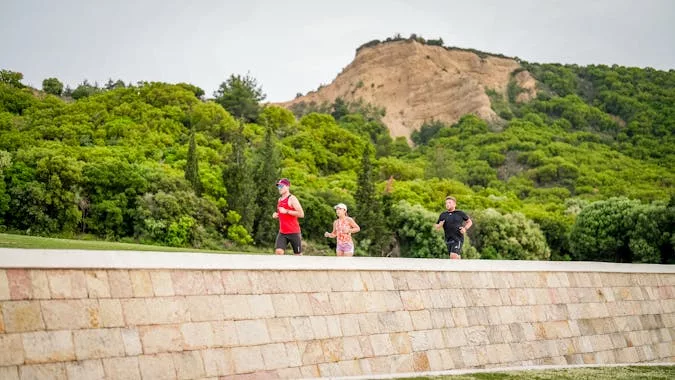
Long hikes are an incredible adventure, but they can also be physically demanding. Whether you’ re tackling a multi-day trek or a single long-distance day hike, proper training is essential to build endurance, strength, and confidence on the trail. Without preparation, fatigue and injuries can cut your adventure short.
In this guide, l cover everything you need to know about how to train for a long hike, from building endurance to strengthening your legs and improving balance.
What is a Long Hike?
This is really a matter of opinion for me anything 25 km or more starts to enter the long distance category.
For a novice hiker the 10 km mark may be what they consider long distance. for others it may be a distance they have never completed before.
Why Training for a Long Hike Matters
Hiking long distances requires more than just enthusiasm, it demands physical and mental preparation. Training helps you:
- Build stamina to hike for hours without exhaustion.
- Strengthen muscles and joints to handle rugged terrain.
- Improve balance and stability for uneven trails.
- Reduce the risk of injuries like knee pain, blisters, or muscle strains.
- Boost confidence so you can enjoy the journey without worry.
Start with an Honest Fitness Assessment
Before jumping into training, assess where you’re at.
- How far can you comfortably hike right now?
- Do you feel strong on inclines and declines?
- Do you have any past injuries that might need extra attention?
Understanding your current fitness level helps you create a realistic training plan and avoid overtraining, which can lead to injuries.
Build Endurance: Hike and Walk More
Start Walking Regularly
The best way to prepare for a long hike is to walk often. Start with your base point a few times a week. This is a distance that is the maximum you are comfortable walking, then gradually increase distance and intensity.
Progress to Longer Hikes
Try to hike at least once a week, increasing the distance and elevation gain gradually. If your goal is a 15 km (9-mile) hike, work up to at least 12 km (7 miles) in training.
Add Elevation to Your Training
Hiking uphill strengthens your legs and improves cardiovascular fitness. If you don’t have access to hills, train on a treadmill with an incline or use stairs.
Strength Training for Hiking
Strong legs, core, and upper body muscles will help you hike longer with less fatigue. Aim to strength train 2 – 3 times a week.
Best Exercises for Hiking Strength
Legs & Glutes
- Squats: Builds overall leg strength.
- Lunges:Improves single-leg strength for uneven terrain.
- Step-ups: Mimics stepping onto rocks and ledges.
Core Strength
- Planks: Supports posture and stability.
- Russian Twists: Helps with pack balance on uneven ground.
Upper Body (for carrying a backpack)
- Rower: Builds back, shoulder and arm strength
- Push ups: Strengthens your chest, shoulder and triceps. plus your core as an added bonus

Improve Cardiovascular Fitness
Hiking requires endurance, so mix in other cardio workouts like:
- Cycling: Great for leg endurance without impact.
- Running: Helps improve stamina quickly.
- Swimming: Low-impact cardio for full-body conditioning.
- HIIT workouts: Boosts endurance with short, intense sessions.

Train with a Backpack
Since you‘ll be carrying a pack on your hike, train with it early on.
- Start with a light weight of a couple of kilos or pounds and build up gradually.
- Ensure a good fit to avoid back and shoulder strain.
- Practice different terrains so your body adjusts to real conditions.
Work on Balance and Flexibility
Hiking involves uneven surfaces, so good balance is key.
- Single-leg exercises: Standing on one leg helps improve stability.
- Yoga or stretching: Improves flexibility and reduces injury risk.
- BOSU ball exercises: Helps train for rocky or uneven trails.

Simulate Trail Conditions
Try to train in environments similar to your upcoming hike. If the trail has:
- Rocky paths, train on rougher terrain.
- Steep inclines, hike or use stair workouts.
- High altitudes, train at higher elevations if possible.
- Variable weather, train in different conditions to build resilience.
Hike Preparation
Stretching is important before starting and exercise. It helps to prepare your muscles and can prevent injuries. Here is my guide on pre-hike stretches.
Nutrition and Hydration During Training
Fueling your body properly is just as important as training. You can read more on this here.
Before Training Hikes
Eat a balanced whole foods meal with carbs, protein, and healthy fats
During Training Hikes
- Drink plenty of water (500 ml – 1L per hour, depending on weather). More information on hydration is here.
- Take electrolytes if you know you sweat a lot or it’s a hot or humid day. My recommended brand is LyteShow.
- Snack on energy-dense foods like nuts, protein bars, or dried fruit.
After Training Hikes
- Rehydrate and replenish electrolytes.
- Eat protein-rich foods to aid muscle recovery.
Recovery and Injury Prevention
Hiking training can be tough on your body, so recovery is crucial.
Essential Recovery Tips
- Take rest days to prevent overuse injuries.
- Use foam rolling to reduce muscle tightness.
- Do gentle stretching after hikes.
- Get enough sleep to allow muscles to repair.
- I find an Epsom salt bath aids with muscle recovery.

Common hiking injuries like knee pain, shin splints, or blisters can be prevented with proper training and good footwear.
Final Preparations Before Your Hike
As your big hike approaches:
- Taper training (reduce intensity) one week before to allow full recovery.
- Double-check your gear to ensure everything fits and functions well.
- Mentally prepare by visualizing your hike and reviewing the trail map.
My Final Thoughts: Train Smart, Hike Strong
Training for a long hike takes time, but it’s worth it. By gradually building endurance, strengthening your muscles, and preparing for trail conditions, you’ll set yourself up for success.
So, start small, stay consistent, and enjoy the journey, because the best adventures begin with good preparation. Happy hiking!
Are you training for a big hike? Let me know in the comments below!
